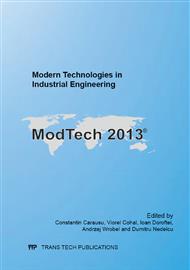[1]
A.C. Bărbînţă, R. Chelariu, C.I. Crimu, B. Istrate, S. Nazarie, K. Earar, C. Munteanu, Investigation of a new Ti-Nb-Zr-Ta alloy by electron microscopy, X-ray diffraction and nanoindentation, Bulletin of the Transilvania University of Braşov, Series I, 6 (55), 1 (2013a) 77-82.
DOI: 10.4028/www.scientific.net/amr.837.259
Google Scholar
[2]
A.C. Bărbînţă, R. Chelariu, C.I. Crimu, B. Istrate, S. Nazarie, K. Earar, C. Munteanu, Metallographic characterization of a new biomedical titanium-based alloy for orthopedic applications, Bulletin of the Transilvania University of Braşov, Series I, 6 (55), 1 (2013b) 83-88.
Google Scholar
[3]
Information on http: /orthoinfo. aaos. org.
Google Scholar
[4]
M. Geetha, A.K. Singh, R. Asokamani, A.K. Gogia, Titanium Based Biomaterials, the Ultimate Choice for Orthopaedic Implants. A Review, Progress in Materials Science, 54 (2009) 397-425.
DOI: 10.1016/j.pmatsci.2008.06.004
Google Scholar
[5]
M. Niinomi, Mechanical biocompatibilities of titanium alloys for biomedical applications, Journal of the Mechanical Behavior of Biomedical Materials, I (2008) 30-42.
DOI: 10.1016/j.jmbbm.2007.07.001
Google Scholar
[6]
M.A.H. Gepreel, M. Niinomi, Biocompatibility of Ti-Alloys for Long- Term Implantation, Journal of Mechanical Behavior of Biomedical Materials, 20 (2013) 407-415.
DOI: 10.1016/j.jmbbm.2012.11.014
Google Scholar
[7]
M.J. Donachie, Titanium: A Technical Guide. Second Edition, ASM International, USA, (2000).
Google Scholar
[8]
S. Nag, R. Banerjee, Fundamentals of Medical Implant Materials, in: R. Narayan (Ed. ), Materials for Medical Devices, ASM Handbook, USA, 2012, 23.
Google Scholar
[9]
U. Tateishi, C. Gamez, S. Dawood, H.W. Yeung, M. Cristofanilli, H.A. Macapinlac, Bone metastases in patients with metastatic breast cancer: morphologic and metabolic monitoring of response to systemic therapy with integrated PET/CT, Radiology, 247 (2008).
DOI: 10.1148/radiol.2471070567
Google Scholar
[10]
V. Brailovski, S. Prokoshkin, M. Gauthier, K. Inaekyan, S. Dubinskiy, M. Petrzhik, M. Filonov, Bulk and porous metastable beta Ti-Nb-Zr- (Ta) alloys for biomedical applications, Materials Science and Engineering C, 31 (2011) 643-657.
DOI: 10.1016/j.msec.2010.12.008
Google Scholar
[11]
Y. Song, D.S. Xu, R. Yang, D. Li, W.T. Wu, Z.X. Guo, Theoretical study of the effects of alloying elements on the strength and modulus of β-type biotitanium alloys, Materials Science and Engineering A., 260 (1999) 269-274.
DOI: 10.1016/s0921-5093(98)00886-7
Google Scholar


